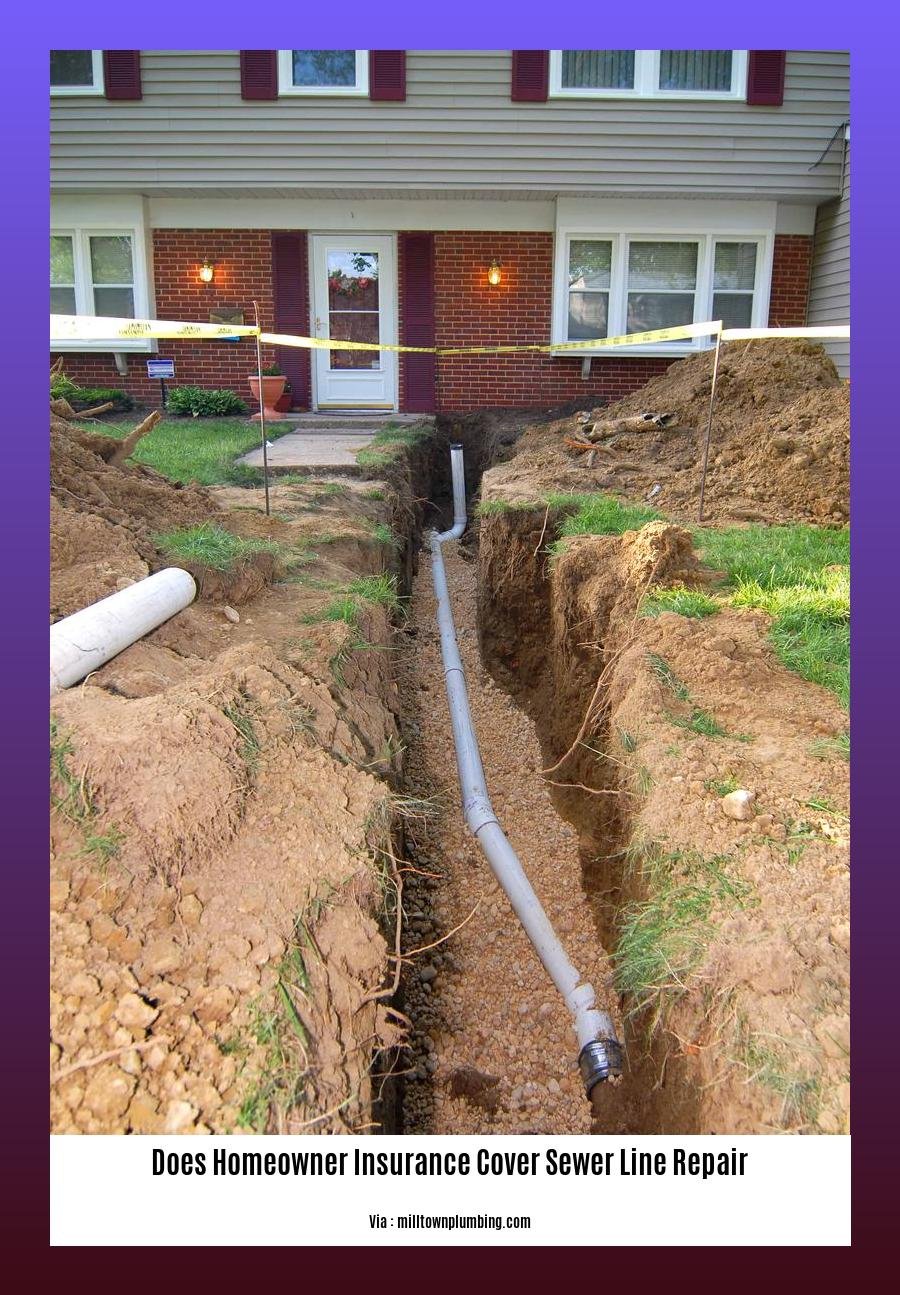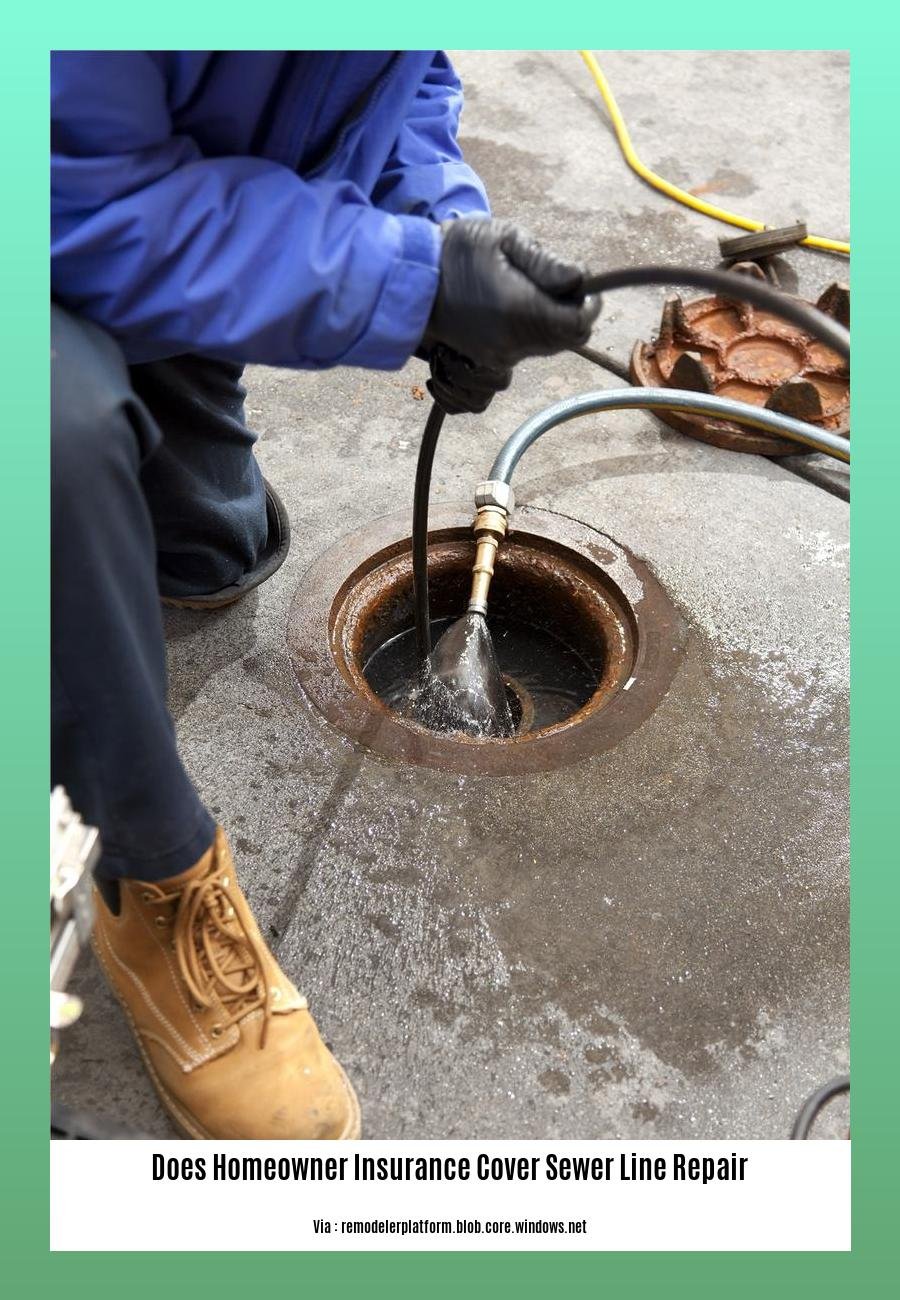Discover the intricacies of homeowner insurance coverage in relation to sewer line repair with our comprehensive guide, [Does Homeowner Insurance Cover Sewer Line Repair: A Comprehensive Guide]. Delve into the specifics of insurance policies, uncovering the details of coverage options and exclusions.
Key Takeaways:
-
Home insurance generally does not cover sewer line repair or replacement unless the damage is caused by a sudden and accidental event listed as a covered peril in the policy.
-
Common causes of sewer line damage, such as faulty construction, poor upkeep, tree roots, pests, or sewage backup, are usually not covered under standard home insurance.
-
Some home insurance companies offer special endorsements or standalone policies for sewer lines or water backup, but these may have limited coverage amounts and additional costs.
-
Homeowners should thoroughly review their policy details and endorsements to determine what is covered and what is not.
Does Homeowner Insurance Cover Sewer Line Repair?

Understanding Coverage and Exclusions
Homeowners insurance plays a crucial role in protecting your property and belongings from various perils. However, when it comes to sewer line repair, the coverage can be a bit murky. In this article, we’ll delve into the intricacies of homeowner insurance and sewer line repair coverage, helping you understand what is typically covered, what’s not, and how to navigate the claims process.
Common Causes of Sewer Line Damage
Sewer line damage can stem from various factors, some of which may be covered by your homeowner’s insurance, while others may not. Below are some common causes of sewer line damage:
-
Sudden and Accidental Events: If your sewer line sustains damage due to a sudden and accidental event, such as a burst pipe or a tree falling on the line, it is likely covered by your homeowner’s insurance.
-
Faulty Construction or Poor Upkeep: Damage caused by faulty construction or neglect, such as improper installation or lack of maintenance, is typically not covered by standard homeowner’s insurance.
-
Tree Roots: Tree roots can infiltrate and damage sewer lines, causing cracks and breaks. Generally, these incidents are not covered by standard homeowner’s insurance.
-
Pests: Damage caused by pests, such as rodents chewing on pipes or insects burrowing into the line, is typically not covered by standard homeowner’s insurance.
-
Sewer Backup: Damage resulting from a sewer backup, where sewage flows back into your home, may sometimes be covered by certain homeowner’s insurance policies. However, coverage for this type of damage can vary widely.
Navigating the Claims Process
Filing a claim for sewer line repair can be a daunting task, especially if you’re unsure about your coverage. Here are some steps to guide you through the process:
Step 1: Review Your Policy:
- Start by thoroughly reviewing your homeowner’s insurance policy to understand your coverage limits and exclusions related to sewer line repair.
Step 2: Contact Your Insurance Company:
- Reach out to your insurance company and inform them about the sewer line damage. Provide detailed information, including the cause of damage, date of occurrence, and estimated repair costs.
Step 3: Document the Damage:
- Take clear photos and videos of the damaged sewer line and the surrounding area. Keep receipts for any repair or replacement expenses.
Step 4: File a Claim:
- Submit a formal claim to your insurance company. This can usually be done online, via mail, or over the phone. Provide all necessary documentation, including photos, videos, and receipts.
Step 5: Hire a Qualified Contractor:
- Once your claim is approved, hire a qualified and licensed contractor to repair or replace the damaged sewer line. Make sure to obtain multiple quotes to ensure you’re getting a fair price.
Conclusion
To ensure adequate coverage for sewer line repair, consider purchasing a special endorsement or standalone policy that specifically covers sewer lines or water backup. Carefully compare different policies and choose the one that best meets your needs and budget. Always remember to review your policy thoroughly and contact your insurance company with any questions or concerns.
-
Do you have old electrical wiring that needs replacing or repairing? Wondering if your homeowner’s insurance will cover the cost of electrical panel replacement? Click here for a detailed explanation.
-
Do you have an old chimney that needs to be repaired? Homeowner’s insurance may cover the cost of repairs. Click here for more information.
-
Are you worried about the potential health risks of asbestos in your home? Some homeowner’s insurance policies may cover the cost of asbestos removal. Click here to find out more.
-
Having issues with electrical problems in your home? Wondering if homeowner’s insurance covers electrical problems? Click here for more information.
Steps to Filing a Claim for Sewer Line Repair Under a Homeowner Insurance Policy

Filing a sewer line repair claim can be an overwhelming experience. But by following these steps, you can make the process smoother and less stressful:
-
Document the Damage:
-
Take clear photos or videos of the damage to your sewer line and surrounding area.
-
Make detailed notes about the incident, including when and how it happened.
-
Keep all damaged items or pieces of the sewer line for inspection.
-
Contact Your Insurance Company:
-
Call the customer support line of your home insurance company.
-
Provide the necessary information about the damage, including the date, time, and cause of the incident.
-
The claims representative will guide you through the process and arrange for cleanup services.
-
Gather Supporting Documents:
-
Keep all receipts related to repairs, cleaning, or damages caused by the sewer line issue.
-
Make a detailed list of any losses or damages to your belongings or home resulting from the incident.
-
Obtain a copy of the plumber’s report detailing the cause of the damage and the repair work performed.
-
File a Formal Claim:
-
You can file a claim online, via mail, or over the phone.
-
Provide all the necessary information and documentation requested by your insurance company.
-
Keep track of all communication with your insurance company and maintain a file of all relevant documents.
-
Hire a Qualified Plumber:
-
Hire a licensed and experienced plumber to repair the damaged sewer line.
-
Get multiple quotes from different plumbers to ensure you’re getting a fair price.
-
Make sure the plumber provides a detailed estimate of the repair costs.
-
Negotiate the Settlement:
-
Review the settlement offer from your insurance company carefully.
-
If you believe the offer is too low, you can negotiate for a higher settlement.
-
Provide additional documentation or evidence to support your claim.
-
Monitor the Repair Process:
-
Keep track of the repair progress and communicate with the plumber regularly.
-
Make sure the repairs are completed according to the agreed-upon timeline and standards.
-
Inspect the repaired sewer line thoroughly before making the final payment to the plumber.
Key Takeaways:
- Document the damage with photos, videos, and receipts.
- Contact your insurance company promptly and file a formal claim.
- Gather supporting documents, including the plumber’s report and receipts for repairs.
- Hire a qualified plumber to fix the sewer line damage.
- Review the settlement offer carefully and negotiate if necessary.
- Monitor the repair process and ensure the repairs are completed to your satisfaction.
What is Sewer Backup Insurance?
What is Sewer Line Insurance? Coverage and Cost
Recommendations for Maximizing a Sewer Line Repair Claim Under Homeowner Insurance
So, you’ve got a nasty sewer line issue, and you’re hoping your homeowner’s insurance will come to the rescue. Buckle up, folks, because maximizing your claim takes some finesse. Let’s dive right in!
Key Takeaways:
-
Understand Your Policy: Dive into the nitty-gritty of your policy to know what’s covered and what’s not. Every policy’s different, so don’t skip this step!
-
Document Everything: This is where photos and videos become your besties. Take lots of them, capturing the damage from every angle. And don’t forget receipts! They’re like gold when it comes to proving your claim.
-
Act Fast: Don’t let that sewer line issue fester. Contact your insurance company ASAP. The sooner you report the damage, the sooner you’ll be on your way to a fix.
-
Choose a Reputable Contractor: When selecting a contractor, don’t just go with the first one you find. Do your research, read reviews, and make sure they’re licensed and insured. A good contractor can make all the difference in getting your sewer line back in tip-top shape.
-
Consider Additional Coverage: If sewer line issues are a recurring nightmare in your area, think about getting a sewer line endorsement or a standalone policy. It’s a small investment that can save you big bucks in the long run.
Additional Tips for a Smooth Claims Process:
-
Be Transparent: Honesty is the best policy, especially when it comes to insurance claims. Be upfront with your insurance company about the cause of the damage and any previous sewer line issues.
-
Stay Organized: Keep all your documents related to the claim in one place. This includes photos, videos, receipts, and correspondence with your insurance company. A little organization goes a long way.
-
Follow Up Regularly: Don’t be shy about following up with your insurance company. A friendly reminder every now and then can keep your claim moving forward.
-
Consult an Attorney (If Necessary): If you’re facing a denied claim or a disagreement with your insurance company, consulting an attorney specializing in insurance law might be a wise move. They can help you navigate the ins and outs of the legal process and fight for your rights.
Remember, maximizing your sewer line repair claim is all about being prepared, organized, and proactive. By following these recommendations, you can increase your chances of a successful claim and get your home back in top condition in no time.
[Relevant URL Sources]
– Does Homeowners Insurance Cover Sewer Lines?
– Does Homeowners Insurance Cover Sewer Line Replacement?
Tips for preventing sewer line issues and mitigating future repair costs
Sewer line issues can create a nasty mess and are an expensive hassle – but there are precautions you can take to minimize the risk of them occurring and to reduce the cost of repairs.
Key Takeaways:
-
Preventive measures:
-
Avoid flushing non-flushable items, like wipes and feminine hygiene products, which can clog pipes and cause backups.
-
Never pour grease or oil down the drain, as these substances can solidify and create blockages.
-
Install a drain catcher in your kitchen sink to catch food scraps and other debris that could clog the drain.
-
Regularly inspect your sewer line for signs of damage, such as cracks or leaks.
-
Trim trees and shrubs near your sewer line to prevent roots from growing into the line and causing damage.
-
Maintenance:
-
Schedule regular maintenance on your sewer line by a qualified plumber, who can identify potential problems before they become major issues.
-
Consider purchasing a sewer line warranty, which can cover the cost of repairs if your sewer line is damaged.
URL Sources:
- Sewer Line Damage: Causes, Signs, and Prevention
- Insurance Guide: Sewer Line
FAQ
Q1: Does homeowners insurance cover sewer line repair or replacement if the damage is caused by normal wear and tear?
A1: No, homeowners insurance generally does not cover sewer line repair or replacement if the cause of the damage is gradual wear and tear, corrosion, or deterioration over time. These issues are considered maintenance problems and are the responsibility of the homeowner.
Q2: What home insurance typically excludes regarding sewer line issues?
A2: Standard homeowners insurance typically excludes sewer line repair or replacement unless the damage is caused by a sudden and accidental event listed as a covered peril in the policy. Common causes of sewer line damage such as tree roots, pests, faulty construction, or poor upkeep are generally not covered.
Q3: Can I purchase additional coverage for sewer line repairs or backup?
A3: Yes, some home insurance companies offer special endorsements or standalone policies for sewer lines or water backup. These policies may have limited coverage amounts and additional costs, but they can provide peace of mind and financial protection in case of sewer line damage not covered by a standard homeowner’s policy.
Q4: What steps should I take if I experience a sewer line issue?
A4: If you experience a sewer line issue, you should:
– Document the damage with photos or videos and note the specific details of the incident.
– Contact your insurance company promptly to file a claim.
– Save all relevant receipts for repairs, cleaning, or damages related to the sewer line issue.
– Contact a qualified plumber to fix the damaged sewer line.
Q5: How can I prevent sewer line problems in my home?
A5: To prevent sewer line problems, you can:
– Properly dispose of grease and oils by pouring them into a sealed container and discarding them in the trash.
– Use a drain catcher to prevent hair, food scraps, and other debris from entering your drains.
– Avoid planting trees or shrubs too close to sewer lines, as their roots can cause damage.
– Get regular sewer line inspections and maintenance to identify and address potential problems early.
- How to Remove Sticker Residue from Clothes: Effective & Safe Methods - April 26, 2025
- How to Get Mustard Out of Clothes: Fast & Effective Stain Removal Guide - April 26, 2025
- How to Get Mustard Out of Clothes: A Complete Guide - April 26, 2025










